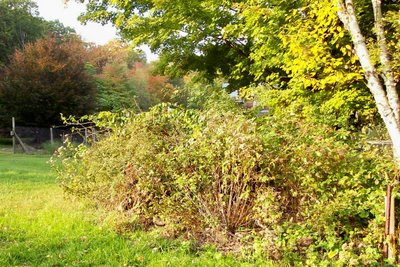Nature Versus Me

Every plant or animal, if unopposed, intends to take over the world.
Possums produce a dozen or more young twice a year; snapping turtles produce 30 to 80 eggs per season; green sunfish produce two to ten thousand eggs at a time. Leave any one of them to their own devices and the world would be taken over by green sunfish or snapping turtles or possum in no time.
But my struggler at the end of the summer is with the green wave encroaching on our clearing. I’ve spent the last few days in armed combat with forsythia. Now, I like forsythia; it’s probably what Robert Frost had in mind when he wrote “Nature’s first green is gold.” I want forsythia along the road to light up the spring world, but forsythia wants not simply to light up the world but take it over.
I remember a column years ago by Russell Baker about forsythia. He had read an article that said one should sharpen one’s clippers before attacking forsythia. “That shows how much they know about forsythia,” snorted Baker. “By the time you get your clippers sharpened, it will be too late.”
I should have confronted my forsythia long before now. Those long graceful branches drop down and root, creating another plant four or five feet away. Mine were planted inside the wall but had climbed over it and were heading for the road. At the rate of four or five feet every year, they might need a hundred years to go a mile, but each plant intends to travel in every direction; at the end of a hundred years the original plant would be at the center of a circle of forsythia two miles in diameter. In another hundred years, the forsythia circle would be four miles across. But that’s just one bush, and there are many.
Barberry bushes are even more aggressive and also produce berries for birds to scatter widely. Last week I was visiting my sister-in-law and inquired about some chestnut trees in her upper orchard. She advised against seeking them out on the grounds that the territory between had become overgrown since I was last there. But I knew the way and thought it couldn’t be that difficult. Little did I know what barberry bushes can do in ten years or so. Half way there I began to feel like Lady MacBeth: “I am in bushes, stepped in so far from shore, returning were as tedious as go o’er.” And those bushes, a dense jungle some five or six feet high, have thorns. They reach out and interweave with other bushes. I was trapped in barberry bushes stretching in all directions and barely made it home.
Watch the border of a New England field and you see the invasion in progress. Barberry bushes are often the advance guard and honeysuckle comes up behind, arches over, and intensifies the jungle. Wild roses add their thorns to the thicket. They send their branches out over the field’s edge and the mower therefore stays away and the thicket advances, a few feet more every year until the clear field is gone.
Moving more solemnly, the trees come up through the thicket, using the briars and thorns to protect them while young. Each oak tree, hickory tree, maple tree, sends down thousands of seeds a year. New England farmers, pursuing their own world conquest scheme, cut them down, but then moved west and into the cities. The bare hills were forested again in fifty years.
Against this ever encroaching horde, I have only a pair of clippers. In the last few days I’ve driven the surge back six or eight feet in some areas but I have other things to do and they don’t. Next summer I’ll be distracted again by the garden and come fall, when I look, they will have regained whatever I captured this fall and advanced in new areas as well.
Deep in the woods are the stone walls my predecessors built around their fields, long overrun and recaptured. Someday a new settler will be walking through the woods and find my rusting clippers in what was once an orchard and wonder who left them there and why.
 Christopher L. Webber
Christopher L. Webber